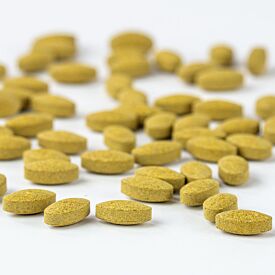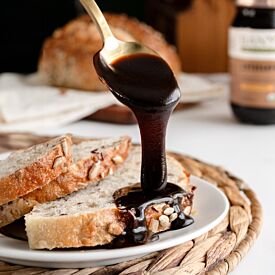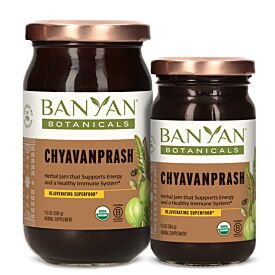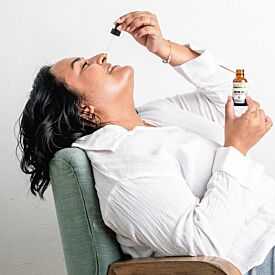Beating the Winter Blues
I never knew what people were talking about when they spoke of the ominous "winter blues." I grew up in Ontario and winters meant playing in the snow, cross country skiing, figure skating, and lots of hot chocolate with those mini pastel-colored marshmallows on top.
In my first decade living in Vancouver, British Columbia, I rarely noticed the shift from fall to winter to spring…probably because there isn’t much of one; we essentially live in a rainforest, a mono-season of rain and grey. Over the last ten years, I’ve noticed the effects of this on my body, mind, and spirit. The short dark days of winter, the lack of sunshine, the impenetrable heaviness of people’s attitudes...am I projecting?
Possibly, yes...AND, I work with a lot of clients in my Ayurvedic practice who struggle even more during the winter with feelings of melancholy, anxiousness, low immunity, poor digestion, and sleep.
We are a microcosm of the macrocosm. In the winter, it is natural to feel the longing to withdraw and retreat, become quiet and still, which is perhaps one advantage to the need to shelter indoors during these pandemic times. It’s the perfect time to meditate upon the loss of what is no longer serving us on our soul’s journey and to lovingly release it, to make space.
But this approach, to see loss as the foundation for renewal—winter before spring—is not welcome or encouraged in our culture. Instead, we medicate with a few glasses of wine in the evening (because red wine is good for you, right?) or numb out on Netflix, watching four seasons of a new binge-worthy show in a week.
Honoring the natural inward rhythm of the season without getting sucked down a black hole of melancholy and despair is the dance. Here are a few ways I’ve discovered to make the dance smoother and more graceful this season.
Meditation
I know, I know, it’s almost annoying how often we hear that meditation is beneficial. In Ayurveda, it’s considered the “first medicine” because manas, the mind, is the origin of most of our symptoms and dis-ease.
Meditation can take so many forms. There’s no need for you to feel constrained by the traditional idea of sitting on a cushion in an austere position for hours on end. The all or nothing approach keeps many people avoiding meditation altogether.
If you have a daily meditation practice, great! If you don’t, try a walking meditation: walk slowly and mindfully while you gently breathe in and out through your nose, or use Ujjayi Pranayama if you’re familiar with it.
The other tool I like to offer my clients is to set an alarm on their phone that goes off every hour. The alarm is the reminder to stop, breathe deeply, and be still for one minute. It’s a wonderful opportunity to check in with yourself and re-cognize if you’re playing out your day in a stressful way or a relaxed one. You can always redirect your focus and energy if your day is starting to go sideways.
Come back to the breath over and over again, as it is the bridge between the body and the mind.

Seasonal Yoga
A daily yoga practice that is aligned with your specific dosha and the season can be the lifeline back to stability and a positive outlook. If your yoga asana is aggravating to vata dosha or the nervous system, then you will end up more frazzled and exhausted by your practice.
During the winter, it’s important to generate internal warmth and invigorate the body without overdoing it. Try the following poses, done mindfully to build heat without overheating.
- Sun Salutation (Surya Namaskar)
- Warrior I and II (Virabhadrasana I and II)
- Forward bends (seated or standing)
- Gentle backbends like Cobra (Bhujangasana), Camel (Ustrasana), or Bow (Dhanurasana)
- Balancing poses, which help establish stability and equanimity, such as Tree (Vrksasana), Eagle (Garudasana), or Lord of the Dance (Natarajasana)
If you’re feeling overwhelmed or anxious, go at a slower pace and include some restorative practices such as Legs Up the Wall (Viparita Karani) and a longer Savasana (Corpse Pose) with an eye pillow or blanket.
For more grounding, try an extra heavy blanket over the legs or abdomen to relax the nervous system and calm excess movement of vata dosha.
Yogic Breathing
Utilizing the breath to redirect the flow of prana and shift your mood has both a physiological and emotional effect. Kapalabhati is the Skull Shining Breath, a yogic pranayama practice to uplift, invigorate, and stimulate. This will help to clear out phlegm and stagnation, remove lethargy, and purify the nadis (energetic channels).
Decrease Sugar
I don’t really need to say too much more about this one. Even though you may grab for the comfort foods, especially when the winter blues set in, by sticking to a whole foods, seasonal diet you will avoid the roller coaster ride that sugar takes you on.
Be mindful of the hidden sugars in processed foods and baked goods. If you need a bit of the sweet taste, choose natural unprocessed sugars such as honey or maple syrup.
Vitamin D3
A few years ago, I was wrestling with the winter blues. I went to the doctor, and she took some tests and found that my vitamin D levels were down in the dumps.
If you live in a place where you actually get sunlight, expose your skin for 10–15 minutes at least a few times per week to keep your serotonin levels balanced. Take off your sunglasses (when safe) and absorb the prana and healing benefits of vitamin D.
The sunlight will stimulate the pineal gland and assist in maintaining a more buoyant mood. If you’re like me and live in a gloomy rainforest in the winter, consider taking liquid vitamin D3 daily.
CommUNITY
Connect with uplifting people who are committed to seeing joy and focusing on what is going right, not wrong. Make an effort to connect with others in a safe way. Go for a socially distanced walk, check in with your friends on social media, or ask a friend to chat on the phone. Stay connected.

Exercise
Move, move, move!
If yoga isn’t your thing, find some way to move your body. Go outside and walk briskly, dance around your living room for five minutes, snowshoe or ski—doesn’t matter what you choose, the goal is to get your heart rate going.
It’s important to move your body so that the lymphatic system, circulatory system, and muscular system stay healthy and fluid. Exercising helps to release endorphins, the feel-good hormones that keep you looking on the brighter side of life.
Nasya
I’ve always found it slightly amusing how much we love to use oil in Ayurveda. Oil “all nine gates,” I learned! And by golly, I think there’s something to this.
Nasya is the practice of oiling the nostrils. To do this practice in all its wonder, lie down with your head tilted back and administer five drops of Nasya Oil in each nostril. Take three deep, quick breaths in and stay with your head tilted back for a couple of minutes.
The mini version, which I do every day in the winter, is to put two drops of nasya oil onto my pinky finger and gently insert the finger into the nostril on both sides, carefully massaging the inner walls of the nasal passage. Do this morning and night.
Nasya is spectacular for relaxing vata agitation, calming the mind, boosting the immune system, supporting sound sleep, and grounding your energy when it becomes scattered.
Herbs, Herbs, Herbs!
I’m not big on dousing myself with herbs from a fear-based place, but I will consciously use them according to what I need for the season, any current imbalances, and according to my stress levels. Working preventatively is always preferred.
I’ve been feeling great this winter and I can attest this to taking Stress Ease, Immune Strong, and Chyavanprash. Of course, you must find what works for you and if you’re unsure, consult with an Ayurvedic practitioner you trust.
Self-Care as Soul Care
The biggest impact that you have on your health is with the things you do consistently, every day. For better or worse. My favorite dinacharya, or self-care practice, this time of year is oil massage. This ancient Ayurvedic practice of abhyanga not only soothes frayed nerves, it’s great for nourishing the skin and the heart.
When you rub warm oil on your body, consciously see and feel your body—stay present (this is a meditation). Bring gratitude to all of the various parts of your body and for everything your body has done for you.
Being Supported
It can feel overwhelming trying to fit self-care into your already full day, but a dose of willingness is your greatest tool to feeling better and better. Getting support in making the changes that you know will transform your health and well-being is essential; otherwise, life tends to get in the way.
I hope that some of these tools will assist you to navigate the darker days of the year and help to keep your spirits bright.













